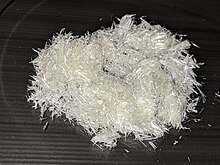 | |
 | |
| Names | |
|---|---|
| Other names Triphenylbismuth | |
| Identifiers | |
| CAS Number | |
| 3D model (JSmol) | |
| ChemSpider | |
| ECHA InfoCard | 100.009.122 |
| EC Number |
|
| PubChem CID | |
| UNII | |
| CompTox Dashboard (EPA) | |
InChI
| |
SMILES
| |
| Properties | |
| Chemical formula | C18H15Bi |
| Molar mass | 440.298 g·mol |
| Appearance | white solid |
| Density | 1.585 g/cm³ |
| Melting point | 77.6 °C (171.7 °F; 350.8 K) |
| Hazards | |
| GHS labelling: | |
| Pictograms | 
|
| Signal word | Warning |
| Hazard statements | H302, H312, H332 |
| Precautionary statements | P261, P264, P270, P271, P280, P301+P317, P302+P352, P304+P340, P317, P321, P330, P362+P364, P501 |
| Related compounds | |
| Other cations | triphenylphosphine triphenylarsine triphenylstibine |
| Related compounds | pentaphenylbismuth |
| Except where otherwise noted, data are given for materials in their standard state (at 25 °C , 100 kPa). Infobox references | |
Triphenylbismuthine is an organobismuth compound with the formula Bi(C6H5)3. It is a white, air-stable solid that is soluble in organic solvents. It is prepared by treatment of bismuth trichloride with phenylmagnesium bromide.
- BiCl3 + 3 C6H5MgBr3 → Bi(C6H5)3 + 3 MgBrCl
Structurally it resembles related compounds such as triphenylstibine. The C-Bi-C angles are 94°.
Triphenylbismuthine serves as a phenyl donor in some cross coupling reactions catalyzed by Pd(0) complexes. It reacts with trifluoromethanesulfonic acid to give bismuth triflate:
- Bi(C6H5)3 + 3 HO3SCF3 → Bi(O3SCF3)3 + 3 C6H6
Triphenylbismuthine readily undergoes oxidative addition to form Bi(V) derivatives such as triphenylbismuthine dichloride.

Related compounds
References
- "Triphenylbismuth". pubchem.ncbi.nlm.nih.gov. Retrieved 9 February 2024.
- Finet, Jean-Pierre; Rao, Maddali L. N. (2013). "Triphenylbismuthine". Encyclopedia of Reagents for Organic Synthesis. doi:10.1002/047084289X.rt358.pub2. ISBN 978-0-471-93623-7.
- Jones, P. G.; Blaschette, A.; Henschel, D.; Weitze, A. (1995). "Redetermination of the Crystal Structure of Triphenylbismuth, (C6H5)3Bi". Zeitschrift für Kristallographie - Crystalline Materials. 210 (5): 377–378. Bibcode:1995ZK....210..377J. doi:10.1524/zkri.1995.210.5.377.
- Rao, Maddali L. N.; Jadhav, Deepak N.; Dasgupta, Priyabrata (2010). "Pd-Catalyzed Domino Synthesis of Internal Alkynes Using Triarylbismuths as Multicoupling Organometallic Nucleophiles". Organic Letters. 12 (9): 2048–2051. doi:10.1021/ol1004164. PMID 20377270.
- Labrouillère, M.; Le Roux, C.; Gaspard, H.; Laporterie, A.; Dubac, J.; Desmurs, J.R. (1999). "An Efficient Method for the Preparation of Bismuth(III) Trifluoromethanesulfonate". Tetrahedron Letters. 40 (2): 285–286. doi:10.1016/s0040-4039(98)02397-1.
- Hawley, David M.; Ferguson, George (1968). "The stereochemistry of some organic derivatives of Group VB elements. Part II. The crystal and molecular structure of triphenylbismuth dichloride". Journal of the Chemical Society A: Inorganic, Physical, Theoretical: 2539. doi:10.1039/J19680002539.
| Bismuth compounds | |||
|---|---|---|---|
| Bismuth(III) |
| ||
| Bismuth(V) |
| ||